Capcom Vs Psikyo developer interview (1997)
with Shinsuke Nakamura (Psikyo) and Yoshiki Okamoto (Capcom).
Source: http://www.http://shmuplations.com/
|
| |
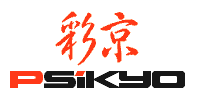 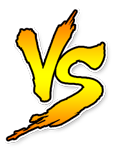  |
|
Psikyo, along with Cave and Raizing, represented the new direction STG was to take in the 90s and beyond. I haven’t been able to find much developer info on Psikyo, but these two short interviews shed some light on their design philosophy and influences. The candid “versus” interview with Yoshiki Okamoto of Capcom is an especially fun read for STG fans.
These interviews were found at the GSLA, a Japanese a website that, among other things, preserves game developer interviews from older, now-defunct print sources. The GSLA often redacts the original interviewer questions, so the text ends up reading more like a narrative than an interview. |
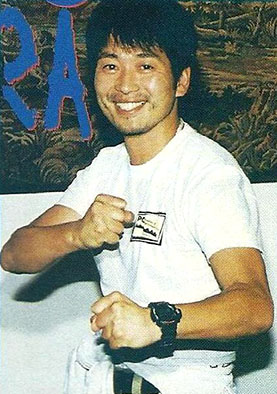
Yoshiki Okamoto, in the mid-90s.
|
 |
|
-
Okamoto: So, Nakamura, how old are you?
Nakamura: I’m 30.
Okamoto: Ah, then you were in middle school when I was working at Konami. That was around the time I made Time Pilot, Gyruss, and other games.
Nakamura: I’ve played those!
Okamoto: I didn’t start making STGs because I liked them, but because they were the only kind of game you could make properly given the technical limitations of the time. That and racing or Pacman style games. When I came to Capcom nobody was making anything other than those. I never played Galaxian when it was popular, but I did like getting the flags in Galaga and played that a lot.
Back then the sprites and objects in games were too small, so that if you tried to make an action game the hitboxes and such wouldn’t be clear to players. “What just hit me! No way!” Therefore, if you wanted to create a game that you could be completely satisfied with, it naturally had to be a STG. The first STG I made at Capcom was 1942, but the game I made before that, SonSon, somewhat resembled a STG since you fire bullets. Though that game emphasized 2P simultaneous play more.
|
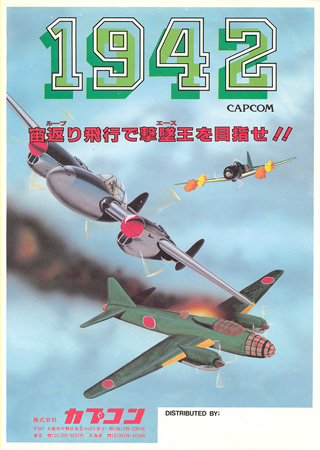 |
-
Nakamura: Time Pilot was one of those games where Americans were better than me, who loved games. In that era you could scratch out a clear with good reflexes alone.
Okamoto: Yeah, Galaga’s bonus stages could be memorized somewhat, but those early games were just about aligning the center of your ship. (laughs) I made Gyruss because I loved Galaga. As for Time Pilot, that was inspired by Bosconian. I wanted to make Bosconian more hectic, with more parts where you have to flip around and fire at enemies.
|
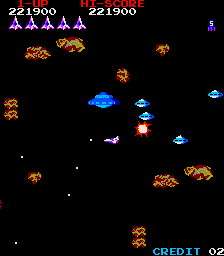
Time Pilot, a multi-directional
shmup inspired by Bosconian. |
Nakamura: And you could fire in 32 directions with Time Pilot.
Okamoto: It was ground-breaking for its time… if I do say so myself. (laughs) But the way we made graphics back then was very primitive. First, I had to draw by hand the ship sprite on dot graph paper, from all 32 angles. Then I entered that data into the computer. However, in the middle of that arduous work, someone destroyed my work with a lighter. I was like, what the hell! |
-
Nakamura: The company I worked at before Psikyo was like that. When I worked on pixel art there I used an Exed Exes cab as my desk.
Okamoto: Ah, Exed Exes, my greatest disgrace. (laughs)
Nakamura: We were short a desk, so.
Okamoto: Yeah, that’s all that game was suited for. Damn! What a good story. Well, let’s get this conversation back on track. (laughs) Nakamura, what STGs do you like?
Nakamura: The first Gradius.
Okamoto: I like that too, and I bought it. I was really surprised to hear that one of my colleagues at Konami made it. Even today Gradius is a classic among classics.
Nakamura: Around this time in STG history, I started to be able to beat those Yankees. (laughs) You couldn’t just rely on reflexes anymore, and you got better at these new games the more time you put into them.
Okamoto: When I would leave Gradius at the office, no one would get any work done. Capcom had just put out Makaimura and it was really popular at the game centers, but our employees were all “Gradius is our generation’s game.” (laughs) That and Xevious.
Nakamura: When Xevious came out I was really shocked.
Okamoto: Did you think, “how could they make a game so beautiful!” ?
Nakamura: Yeah. I played Xevious a lot, but I never got very good at it. It wasn’t until the Famicom version that I could even make the loop. Really good players can get to the end without even firing.
Okamoto: You know, there’s many games I haven’t played, but I think I’ve probably played Capcom’s games the least. How is it for you and Psikyo’s games?
Nakamura: I don’t play our games after we’ve released them.
|
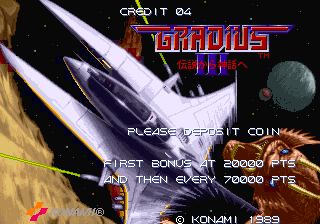  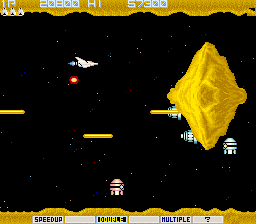
Gradius (known as Nemesis in Europe),
still influential on STG design today.
|
-
Okamoto: When you develop a game, the difficulty is decided by your own level of skill, right? I set it at a level about equal to my own abilities, so its not very objective. There were games like Sidearms, where someone easily cleared it on the first day of the location test, though it had taken me so many months to develop… I was shocked. I thought, do I really suck this bad?
Nakamura: That can happen, yeah. These days I leave the balancing to the very skilled players at Psikyo.
Okamoto: Another problem is that although the PCB cost 200,000 yen to produce, people only play the first 5% or 5,000 yen worth of it. How am I supposed to get the 95% of the money back? Its almost like the latter half of the game doesn’t matter.
Nakamura: Our thinking at Psikyo is similar. The beginning of our games is very important to us. That’s why we make our games so that the first few stages are always different.
Okamoto: That’s a good idea! I’m going to use that!
Nakamura: Yeah, because most people lose all their lives by the first or second stages.
Okamoto: By the way, there’s this image people have of Psikyo, like one day you just appeared of nowhere. Where did you guys come from?
|
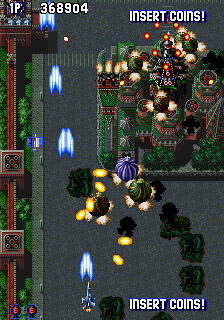
The team that made Sonic Wings at
Video System went on to form Psikyo. |
Nakamura: Kyoto. We sprung up overnight. (laughs) Psikyo was formed by members from the previous development company we worked at, where we also made STGs. People said our first game, Sengoku Ace, was exactly like the games we made at our old company. But at that time we couldn’t think of anything else to make.
Okamoto: Yeah, we’re always limited by our ideas at the time, so no matter how much we try and reach 100% satisfaction with our creations, there’s always that next idea. But even if you think your game is 100% complete, once its released many flaws are certain to appear, so you should really aim for 200%.
Nakamura: Games are living, breathing things, aren’t they. Okamoto: Definitely. By the way, how much did Strikers 1945 II make?
Nakamura: It was so-so. |
-
Okamoto: Yeah, there’s something to be said though, for a game with a lot of replayability, that operators can leave installed for a long time. If it were Capcom we’d have a hard time releasing a game like that. Instead of STGs, we have to put out fighting games that make a lot of money on quick credits. In that sense developers like you are really important to game centers. Still, though, maybe it would be better to raise the price of a credit for STG.
Right now, for 100 yen you get to play for 3 or 4 minutes, right? So lets say you get to play 10 minutes for 200 yen. Now, if you had 200 yen, wouldn’t you rather spend it on a short movie, instead of buying two 100 yen Yonkoma? I think the STG genre needs to start thinking about things like this if its going to survive.
But yeah, Strikers 1945 II was really great, although I don’t know about that title! (laughs) You know, people often say copying titles or gameplay is bad and plaigarism, but all of the games I made borrowed a lot from others. But I did that because I believe our duty is to improve on what has come before. I don’t really think about whether its right or wrong. Besides, I’d have no complaints if someone confused the Psikyo 1945 games with the Capcom 194x series. Actually, I’d be happy about it. (everyone laughs) It was a good idea to use that title, and I was happy see a game this good revive the 194x name.
Ah, by the way, soon I want to make a non-fighting game. We should team up on a STG! Chun Li could be the pilot or something. (laughs)
Nakamura: In a Chinese-style fighter plane.
|
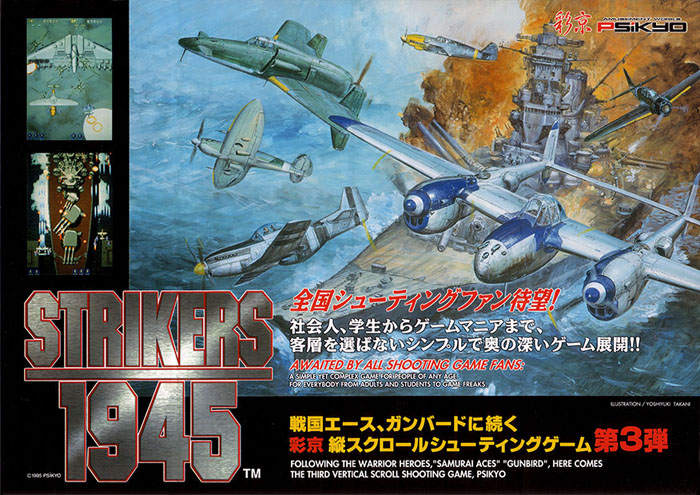
The beautiful Strikers 1945 flyer.
Its too bad a Psikyo-Capcom STG never materialized.
|
-
Okamoto: For Capcom’s approval, “1943 II” would probably work as a title. But as a token of our new friendship, what do you think about co-developing “1944″ ? Actually, I’ve been thinking about a STG that uses a horizontal monitor. You’d have a lot of space to use, and it would be easy to port to consoles. What do you think?
Nakamura: Yeah, actually our latest game, Zero Gunner, uses the model 2 hardware.
Okamoto: Well let’s team up then! Right? Right?!
Nakamura: I, I can’t give such a quick answer no matter how many times you ask! (everyone laughs)
Okamoto: By the way, were you serious about giving me a Strikers 1945 II pcb? Is there a Capcom pcb you’d like to trade for?
Nakamura: Rival Schools!
Okamoto: Sounds good, I’ll get one for you then. So what’s in store for Psikyo?
Nakamura: Until now we’ve been releasing about 3 games per year, but starting this year we’ll be releasing more games. There will be more STGs, of course. I suppose the main thing I want to say is: remember the Psikyo name.
Okamoto: There’s something gloomy sounding about that. (laughs)
Nakamura: Well, its best to start off modestly.
Okamoto: For me, I want to show people another side of Capcom, an unknown side. And to make a game with Psikyo! I’m going to keep bugging you about this!
|
|
Bonus: Psikyo developers interview (1997).
with Shinsuke Nakamura (Director)
and Akifumi Yamada (Productor / Scriptwriter)
Source: http://www.http://shmuplations.com/
|
|
-
Psikyo's beginnings.
Nakamura: We had experience developing STGs from the company we had worked with before, and we wanted our first release to be a solid one, so for our first game we made Sengoku Ace. We did a variety of research, by which we gradually came to see what kind of game would be best for the current market. We wanted to make a STG that players would find distinct from other developer’s games. Even people who are bad at STGs can enjoy playing our games, I think.
Yamada: The story for Sengoku Ace was very important to us, so we pushed the characters to the forefront. The simplicity of the rules was also very well-received, as was the unique world and character designs done by Hirofumi Nakamura, who has some really passionate fans. Character design in older STGs has sometimes been done in a slapdash, careless manner, so I think we’re a pioneer in having more prominent characters in this genre. Its becoming a more and more important thing to include in game development nowadays.
Nakamura: Unfortunately, the sales and production of Sengoku Ace were handled by another company, so we couldn’t get the Psikyo name out there much.
Yamada: Back then the arcade developers often weren’t acknowledged. But if a salaryman or other player finds the game fun, they’ll play it regardless of who the developer was.
|
|
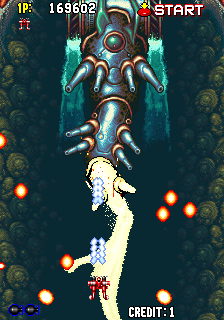
Sengoku Ace is the first work made by Psikyo (pronouced "Sai-kyo",
which sounds like "strongest" in Japanese) has lots of
similarities between this title and Sonic Wings. |
-
Nakamura: Even if we can’t reach 100% perfection with a game we’re developing, we still work until we’re satisfied with it. What ever little things are lacking we resolve to include in the next game. We are especially careful about always making player deaths feel fair. As a general rule in our games, players will only die when they hit a bullet.
Yamada: We also observe the rule that nothing else should share the same colors as enemy bullets. Other than that, we’re pretty open.
Nakamura: Yeah, we’ve stuck to that rule pretty consistently since our second game, Gunbird. The truth is, Toaplan really laid out the foundations of STG when they made Hishouzame. All the basic design of today’s vertical STGs can be found there.
Yamada: Each time we make a new game, it feels like “this is the limit, we can’t go any further.” And yet we always put out another. (laughs) We work hard to make it so our new games don’t just feel like graphic re-skins.
|
-
Stage design.
Nakamura: We’ve also shortened the time you spend in stages before the boss. It allows for variety and it makes the arcade operators happy, as well as the customers waiting for their turn to play.
Yamada: Of course, if the experience is simply short then players will feel cheated, so we make sure the stages are densely packed.
Nakamura: The first half of our games are relatively easy to get through and enjoy, but in the latter half we design them so that memorization is important. Skilled players might be able to clear them without much memorizing after a number of credits, though. With STGs, you can see the skill gap between players quite clearly.
|
-
Yamada: But with this style, skilled players, unskilled players, and every one in between can enjoy the game.
Nakamura: The main reason we made the ships in our horizontal STGs human characters is that they look cool when viewed from the side. Jets and planes look cooler when you view them from a top-down perspective.
Yamada: Sol Divide is really the culmination of our practice of emphasizing the characters in our games. Sengoku Ace used planes that matched the personality of the human characters, Gunbird had characters riding things that matched the characters, and now we’ve arrived at characters that are just flying themselves. (laughs) Let’s just say they fly through magic. The game has melee attacks too, so it could also be considered an action game.
|
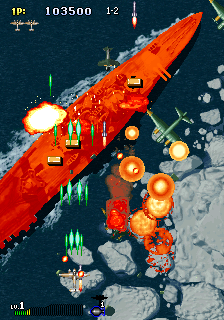
Strikers 1945 II screenshot.
|

Hirofumi Nakada also did a Gunbird manga. |
-
The future of STG and Psikyo.
Nakamura: In the future, I think you’ll see really interesting things in STGs as they pursue a mix of 2D and visually impressive 3D elements. Perhaps someone will make a Virtual On-ish competitive STG too? At heart, STGs are an accessible and easy to understand genre, so though their form may change, I think the genre will remain.
Yamada: Just as we say with our STGs at Psikyo, if its interesting we’ll try it. This year we’re planning to release a 2D fighting game.
Nakamura: The date isn’t decided yet, but very soon.
Yamada: As far as consoles go, we’re actually using the most cutting-edge arcade technology available now, so even on the Saturn, a perfect port is impossible–though in terms of the fun and appeal of a given game, we can create a “perfect” port. The Gunbird port got good reviews but we had to reduce the complexity of certain bullet patterns. But we definitely are wanting to do more console ports, provided a port is technologically feasible and there’s demand. We also don’t mind if you send us your comments or criticisms about our work. We’re a company that’s very receptive to our player’s opinions.
Nakamura: Thank you for your continued love and support of Psikyo STG.
|
| |
|
|
|
|
|















